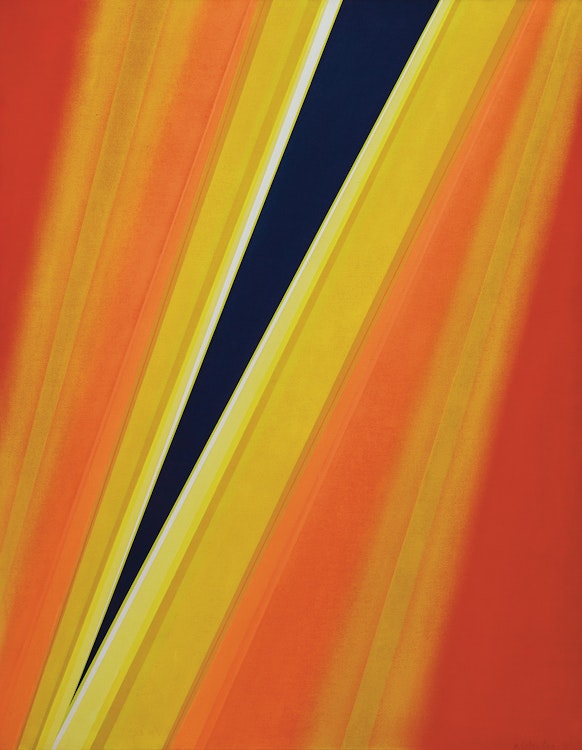WYKI by Rita Letendre

Rita Letendre
WYKI
acrylic on canvas
signed and dated 1975 lower right; signed, titled and dated on the reverse; unframed
60 x 48 ins ( 152.4 x 121.9 cms )
Auction Estimate: $20,000.00 - $25,000.00
Price Realized $26,400.00
Sale date: November 22nd 2021
Private Collection, Ontario
Joan Murray, “Canadian Art in the Twentieth Century”, Toronto, 1999, pages 99 and 122
Wanda Nanibush and Georgiana Uhlyarik, “Rita Letendre: Fire and Light,” Art Gallery of Ontario, 2017, pages 17-19
Letendre’s large canvases of the 1970s explore her fascination with depicting speed and vibration. The use of the airbrush technique, combined with sharp wedges or arrows that cut across the image plane, are characteristic of her work from the decade. In “WYKI” a black ‘arrow’ shoots downward across the canvas, dividing a quasi-symmetrical order of white, beige, orange and fuschia bands. These colourful bands vary in width and paint application; some of them are sharply contrasted while others blend softly into one another, as a result of the airbrush. Wanda Nanibush writes: “The use of an airbrush gave her considerable control over texture and coverage so she could execute pure, flat, evenly distributed arrows. The airbrush, coupled with tape, allowed for the colours to be butted up against each other in perfect lines.” Joan Murray discusses these important works produced by the artist during the 1970s, including “WYKI”, stating: “Rita Letendre explored colour, line and composition through the use of forceful chevrons that cut across the composition diagonally or horizontally from one corner of the painting to the other. She obtained extra energy from applying narrow ridges of contrasting colour to the borders of each ray.” The sharp lines of bright colour all converge to a single point at the tip of the black ‘arrow’ in these works, magnifying and concentrating the energy.
Share this item with your friends
Rita Letendre
(1928 - 2021) RCA
Canadian painter, muralist, and printmaker Rita Letendre was born in Drummondville, Quebec, in 1928. She is of Iroquois descent. Letendre and her parents moved to Montreal in 1941. She settled in Toronto in 1963. In part, Letendre is self-taught but she studied at the Ecole des Beaux-Arts in Montreal for year and a half. While in school she was introduced to the Automatistes due to pamphlets announcing the locations of their new paintings.
Encouraged by Borduas, Mosseau, and Ferron’s art, Letendre began exploring similar motifs in her paintings and began exhibiting with the group from 1952-55. In 1955 she exhibited in “Espace 1955” at the Montreal Museum of Fine Arts. Sharing a studio with fellow Automatiste painter and sculptor, Ulysse Comtois, Letendre became the subject of an article by the Weekend Magazine on non-objective Montreal-based painters. Then, in 1959, Letendre was included in the Third Biennial Exhibition of Canadian Art. In the following year the National Gallery of Canada included Letendre in their Non-Figurative Artists of Montreal exhibit that traveled throughout Canada. In 1962, Letendre received a travelling grant from the Canada Council and traveled to Paris, Italy, Israel, Spain, Belgium, and Germany.
Using a variety of techniques and media such as brush, spatula, pastel, silkscreen, and airbrush, Letendre was a leading member of the colourist movement. Exhibited in over sixty-five solo exhibitions, Letendre’s work can be described in three distinct periods. Her first period, known as the Montreal years, was inspired by her first meeting with Borduas and was a rich exploration of self-discovery. Letendre’s second period was inspired by Russian-born sculptor Kosso Eloul, who later became her husband. Her final period was rooted in mourning and love.
Letendre’s works vary in size from grand murals that are sixty feet by sixty feet in size to small projects on silkscreen. These works are collected throughout the North American continent by governments and public and private galleries and organizations. Letendre’s work has been exhibited in Europe, Israel, Japan, and throughout North America in New York City, Los Angeles, San Francisco, Detroit, Montreal, Toronto, and Vancouver.
Literature Sources:
"A Dictionary of Canadian Artists, Volume II”, compiled by Colin S. MacDonald, Canadian Paperbacks Publishing Ltd, Ottawa, 1979
Roumanes, Jacques-Bernard. “Rita Letendre: Le tableau ivre.” Vie des Arts 45, 183, 2001
Andersen, Marguerite. “Rita Letendre: Énergie et luminosité. L’art du féminin, 12 2004
We extend our thanks to Danie Klein, York University graduate student in art history, for writing and contributing this artist biography.

